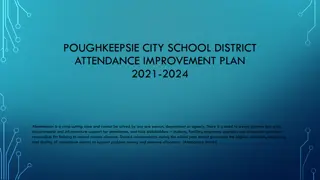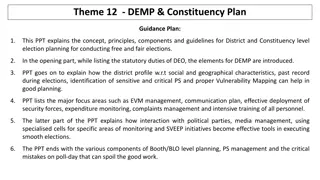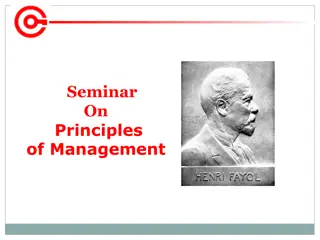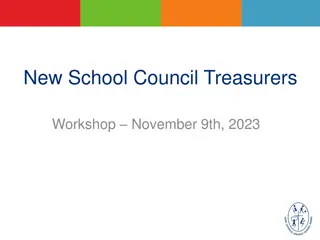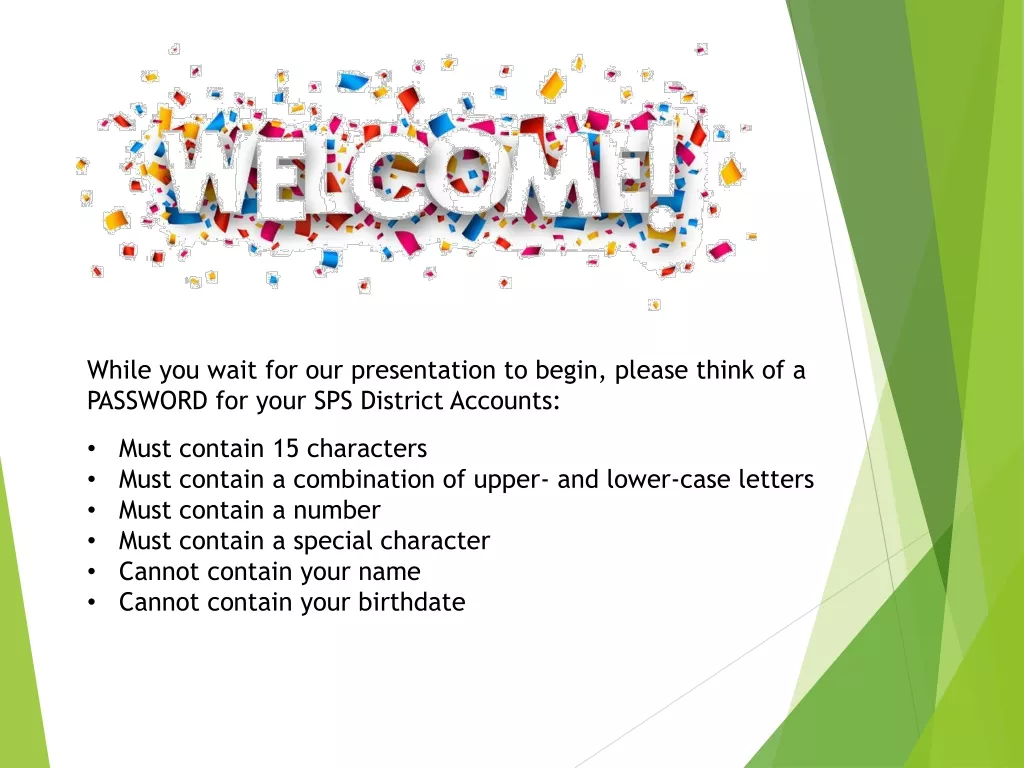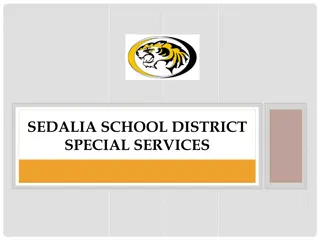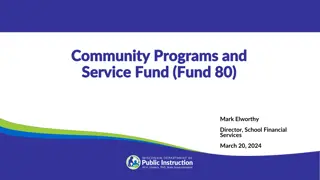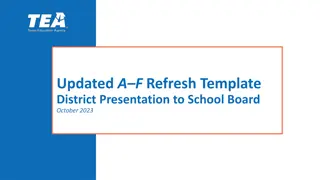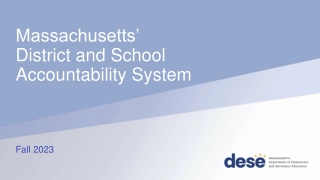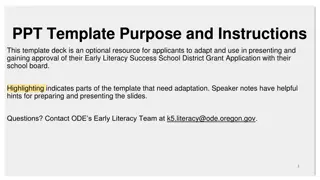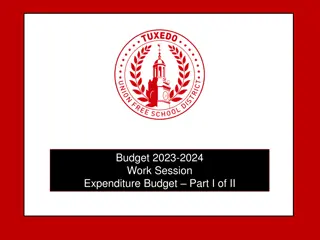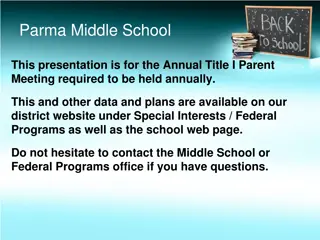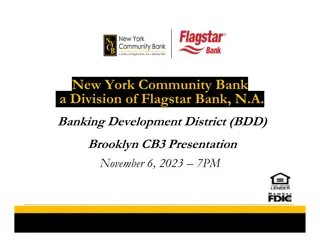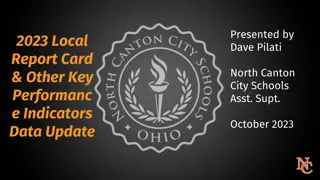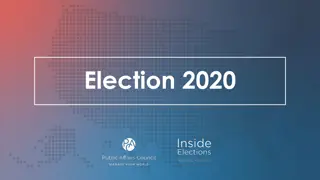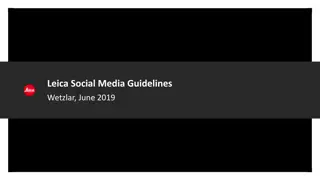Financial Principles and Guidelines for School District Management
Providing detailed information on Tier 1 resources, financial training requirements, qualifications for general business managers, teacher salary guidelines, and the Teacher Salary Equalization Fund for school districts in the upcoming years. Emphasizing the importance of fiscal responsibility and compliance with regulations to ensure financial stability and support for educators.
Download Presentation
Please find below an Image/Link to download the presentation.
The content on the website is provided AS IS for your information and personal use only. It may not be sold, licensed, or shared on other websites without obtaining consent from the author. Download presentation by click this link. If you encounter any issues during the download, it is possible that the publisher has removed the file from their server.
Presentation Transcript
TIER 1 2023-2024
Tier 1 Tier 1- -New! New! Condensed Detailed Tier 1 Resource Guide Inclusion of Financial Principles
Tier 1 Tier 1- -Training Training Tier I Tier II At a minimum: Superintendent/Director & person whose job responsibilities include preparing the budget or overall accounting responsibility. Employees who are in involved in the process of recording and/or reporting of financial transactions. School district trainers must attend Tier I. Initial training of those two people must be a minimum of 12 hours. Training materials should be based on Tier I material and focused on the specific needs of school district employees. Additional training may be required based upon audit findings and/or indicators of fiscal distress.
General Business Manager General Business Manager Must complete at least 5 CASBO courses per year and complete the 15 courses required within 3 years. Must renew certificate by completing at least 2 upper level CASBO courses per year after the date of certification. Failure to comply with rules concerning general business manager qualifications can be an indicator for fiscal distress.
Minimum Wage/Teacher Salary Minimum Wage/Teacher Salary Insurance & Retirement Matching Insurance & Retirement Matching Classified minimum wage remains at $11 per hour.
Minimum Wage/Teacher Salary Minimum Wage/Teacher Salary Insurance & Retirement Matching Insurance & Retirement Matching July 1, 2023: Teacher retirement school district match: 15% Teacher retirement employee match: 7% Outsourcing contribution to ATRS: 4% Beginning July 1, 2023, the health insurance match is $234.50 per month.
Teacher Salary Equalization Fund Teacher Salary Equalization Fund Funding is $185 multiplied by the prior year ADM for qualifying districts. In 2023-24, districts with average teacher salary less than $51,822 will qualify. Districts that received equalization funding in 2022-23 are guaranteed to receive at least the same amount in 2023-24 and beyond. Teacher salary equalization funding shall be expended only for teacher salaries and benefits. 7
School Elections School Elections Per article 14 of the Arkansas Constitution, every school district must submit the tax rate at the annual school election or special election. This applies to all districts, even those under state control. HB 1495 (Act 721)- Requires a school district to file the rate of tax for the school district with the county clerk 72 days before the annual school election, and 89 days before the annual school election in Presidential election years. 8
School Elections School Elections HB 1531 (ACT 547) Allows voters to place on the ballot of any annual school election the issue to determine whether to elect the school district board of directors from single member zones, at large, or a combination of both, expands board of director terms to 4 years. HB 1534 (ACT 424) Repeals the election procedures that apply to school district board members for school districts with a 10% or greater minority population. 9
Tax Appeals and County Tax Appeals and County Equalization Boards Equalization Boards Taxpayers can appeal real estate assessments. Must be heard by the County Equalization Board School district superintendents of each school district in a county shall select (by majority vote) a member of the county s equalization board (A.C.A. 26-27-304). Contact your county assessor to find out who your district s representative(s) are on the County EQ Board 10
Homestead Tax Credit and Property Homestead Tax Credit and Property Tax Relief Tax Relief HB 1032 (ACT 315)- Increases the amount of the homestead property tax credit from $375 to $425. 11
Local Taxes Local Taxes Districts foundation funding amount is comprised of state funding and local revenue. State funding guarantees the first 25 mills only. Go to the Local Tax by Mill Type Calculator to break out your tax receipts by mill type category (URT, debt service, etc.). Districts should verify with county offices (including fringe counties) that they have the correct millage for the district. Not doing so could result in a loss of anticipated revenue for your district! 12
School Funding Website School Funding Website Allocations Lists of funding amounts for each funding source. Funding Data Shows data that is used in calculating the various types of funding. Tools & Resources Provides tools designed to help school district and charter staff with funding estimates such as student growth, declining enrollment, and local taxes by mill type. 13
Efficiency and Management Tools Efficiency and Management Tools Fiscal Efficiency and Management Tools- Various reports and tools such as enrollment projections, staffing trends, staffing requirement worksheet, meals per labor hour, and custodial staffing guide. 14
Adequacy Adequacy 15
Adequacy Adequacy 16
Adequacy Adequacy 17
FY 24 Funding Amounts FY 24 Funding Amounts Foundation amount: $7,618 (Increase of $205) ALE: $4,987 (Increase of $97) ELL: $366 PD: Calculated and put on State Aid Notice (2023 amount = $37.50) ESA: Enhanced Student Achievement ESA state categorical funding (yearly transition = rate at former level up or down $179) o $1,613 if 90% and above o $1,076 if at least 70% and less than 90% o $538 if less than 70% Enhanced transportation: ACT 238 of 2023 18
Miscellaneous Funds Miscellaneous Funds Calculated miscellaneous funds count towards a district s foundation funding, thus reducing the amount of state foundation funding aid that a district receives. 19
Net URT Revenues Net URT Revenues County treasurers submit calendar year ad valorem tax reports by January 31st. Districts should check the report to ensure accuracy. Total ad valorem tax is multiplied by the ratio of the school s millage rate and the uniform rate of tax (URT) to arrive at Net Revenues. Net Revenues > 98% of the URT multiplied by the property assessment = school district remits amount over 98% to DESE. Net Revenues < 98% of the URT multiplied by the property assessment = school district receives payment from DESE to true up to the 98%. 20
Open Open- -Enrollment Public Charter Enrollment Public Charter School Foundation Foundation Funding Funding & Charter Facility Funding & Charter Facility Funding School State State For the first year of operation, the first year operating under a new license, the first year adding a new campus, and in any year a grade is added at any campus: o Foundation funding and charter facilities funding for an open-enrollment public charter school will be based on current year three-quarter ADM from cycle 7. Until this is available: First estimate uses current year July 1 enrollment Second estimate uses current year quarter 1ADM from cycle 3 Third estimate uses current year three-quarter ADM from cycle 6 Final adjustments (if necessary) for any ADM corrections submitted in cycle 7 made in July. Charter schools must meet the eligibility requirements listed in A.C.A. 6-23-908 to receive facilities funding. 21
FY24 Student Growth Funding FY24 Student Growth Funding Calculation: FY24 student growth funding will compare: o FY23 quarter 4 ADM to FY22 3-quarter ADM from cycle 7 o FY24 quarter 1 ADM from cycle 3 to FY23 3-quarter ADM o FY24 quarter 2 ADM from cycle 5 to FY23 3-quarter ADM o FY24 quarter 3 ADM from cycle 6 to FY23 3-quarter ADM Comparison: An eligible school district will receive the higher funding category after comparing student growth funding to declining enrollment funding. 22
FY24 Student Growth Funding FY24 Student Growth Funding Expenditure: Student growth and declining enrollment are unrestricted funding categories, but expenditures are tracked for reporting to the legislature (no transfers out of these codes). See calculator tool on the DESE School Funding website Tools & Resources. 23
ESA Requirements ESA Requirements Districts shall submit a 3-year plan by July 1, 2022, describing the district s strategies to enhance student achievement. Plans can be updated as needed. Districts shall review progress on the ESA plan and submit amendments annually. 24
ESA Requirements ESA Requirements Districts shall budget 100% of ESA funds each year. A district that does not demonstrate progress toward goals in the ESA plan for three consecutive years may be subject to additional monitoring, and increased level of support as provided in 6-15-2913, or a corrective action plan to be developed by DESE and the school district. If a district intends to transfer ESA funds to other categorical funds, justification shall be provided to DESE. 25
ESA Required Expenditures And ESA Required Expenditures And Balances Balances Districts required to spend 85% of annual ESA allocation by June 30 of each year. Districts that have an ESA balance in excess of 15% of the current year allocation, shall reduce the total ESA balance by at least 10% in each year that follows. 26
Categorical Categorical Balances Balances Requires that the balance of all categorical funds be no more than 20% of annual categorical fund allocations for the current school year. If the balance exceeds 20%, the district is required to reduce the balance by 10% each year until the district s June 30 balance of aggregate annual categorical fund sources is 20% or less of the total aggregate annual state categorical fund allocations for the current school year. 27
Limitation on Fund Balances Limitation on Fund Balances Districts with a year end net legal balance that exceeds 20% of current year net legal balance revenues shall reduce the net legal balance to no more than 20% of current year net legal balance revenues within 5 years. o Balances required to be transferred to Fund 3200. o General building transfers to fund 3000. o Review monthly on APSCN website at the following link: http://www.apscn.org/reports/hld/distinfo/distinfo.htm 28
Limitation on Fund Balances Limitation on Fund Balances Net legal balance is the combined balance for the teacher salary fund, the operating fund, and the debt service fund; minus the combined balance for categorical funds and escrow balance restricted for the retirement of federal qualified bonds. o Net legal balance revenues are the revenues placed in the salary fund, the operating fund, and the debt service fund; minus revenues placed in the categorical funds and proceeds derived from federal qualified bonds. 29
Limitation on Fund Limitation on Fund Balances Balances Districts balances may be reduced by transferring funds into the building fund. Funds transferred into the building fund must be used for construction, renovation, repair, or other planned expenditures. 30
Limitation on Fund Limitation on Fund Balances Balances If the building fund expenditures are canceled, and transferring the funds back to the fund from which they came would increase the net legal balance to more than 20%, the district may spend the funds on: o Prekindergarten programs, o Remediation programs, o Career and technical education or workforce readiness programs, or o Any other program or for any other purpose allowed by law. 31
M&O 9% Balance M&O 9% Balance If any amount of the M&O dedicated nine percent (9%) is unspent at the end of the school district's fiscal year, the funds shall carry over, and the school district must transfer the remaining amount into a public school facilities escrow account. 32
ESSER Obligation Timeline ESSER Obligation Timeline Obligation Timeline September 30, 2022 Fund ESSER l ESSER ll September 30, 2023 ARP ESSER September 30, 2024 ARP HCY (Homeless) September 30, 2024 EANS (CRRSA) September 30, 2023 September 30, 2024 EANS (ARP) 33
Arkansas Public School Arkansas Public School Procurement Bidding Procurement Bidding The board of directors of each school district shall prescribe the method of soliciting bids and may adopt other rules governing the procurement of commodities. Districts may adopt state procurement procedures as district policy except where they conflict with Title 6. Purchases exceeding the purchase price amount listed in A.C.A. 6-21-304(a)(1)(A)(i)(a), as adjusted pursuant to A.C.A. 6-21-304(a)(1)(B), shall be procured by soliciting bids. 34
Arkansas Public School Arkansas Public School Procurement Bidding Procurement Bidding Purchasing official may reject all bids and purchase the commodity by negotiating a contract. o If purchasing official determines purchase should be made by negotiation, each responsible bidder who submitted a bid shall be notified of the determination and given the opportunity to negotiate. Open market purchases may be made when purchase price is less than the purchase price threshold as adjusted in A.C.A. 6-21-304 (a)(1)(B). 35
Arkansas Public School Arkansas Public School Procurement Bidding Procurement Bidding Commodities means all supplies, goods, material, equipment, machinery, facilities, personal property, and services other than personal and professional services purchased for or on behalf of the school district. 36
Arkansas Public School Arkansas Public School Procurement Bidding Procurement Bidding The following commodities may be purchased without soliciting bids: Commodities in instances of an unforeseen and unavoidable emergency (see further requirements in A.C.A. 6-21-305). Commodities available only from the U.S. government. Utility services. Used school buses, used equipment and machinery (definition of used school bus in A.C.A. 6-21-306). Commodities available only from a single source. o purchasing official must determine in writing that it is not practicable to use other than the required or designated commodity or service, and a copy of this statement shall be attached to the purchase order. 37
Arkansas Public School Arkansas Public School Procurement Bidding Procurement Bidding State procurement laws and rules can be found on the website of the Office of State Procurement. In the document State of Arkansas Procurement Laws and Rules , school districts fall under the category of political subdivisions. Office of State Procurement has contract administration best practices guide on the website. Public schools may purchase off the statewide contracts. 38
Arkansas Public School Arkansas Public School Procurement Bidding Procurement Bidding Public schools may use a purchasing agreement established by another governmental entity (example: TIPS). For projects (major repairs/alterations, new buildings/structures) with an estimated cost of $50,000 or more, there are specific requirements including advertising, sealed bids, timelines for awarding bids, bid bond, performance bonds, and contractor licenses (A.C.A. 22-9- 203). 39
Arkansas Public School Arkansas Public School Procurement Bidding Procurement Bidding It is the policy of the State of Arkansas and its political subdivisions that political subdivisions (which includes school districts) shall follow the procedures for professional services stated in A.C.A. 19-11-801 et seq.,except that competitive bidding shall not be used for the procurement of legal, financial advisory, architectural, engineering, construction management, and land surveying professional consultant services. A political subdivision (school district) shall not use competitive bidding for the procurement of other professional services with a two-thirds vote of its governing body (school board) A.C.A. 19-11-802 The Office of State Procurement has published a memo on Cooperative Procurement for School Districts. 40
Procurement Reminders Procurement Reminders A.C.A. 6-21-307 School districts may purchase a new motor vehicle from a motor vehicle dealer if the purchase price does not exceed the fleet price awarded by the Office of State Procurement. A.C.A. 6-21-306 The purchase of used school buses (used means two years after date of issuance of certificate of origin) is not subject to competitive bidding. A.C.A. 6-21-301 et seq. The board of directors of each school district shall prescribe the method of soliciting bids and may adopt other rules governing the procurement of commodities. Effective July 1, 2023, the threshold is adjusted to $24,800. A.C.A. 19-11-801 contains additional requirements regarding procurement of professional services for school districts. 41
Federal Procurement Federal Procurement Procedures Procedures All federal expenditures must be allowable, reasonable, and essential to the success of the federal program. Micro-purchases (under $10,000) do not require competitive bid; requires distributing purchases among qualified suppliers to the extent practicable. Small Purchases ($10,000 to $249,999) - require price quotations from at least two qualified sources. Purchases of $250,000 and greater require formal bidding procedures sealed bids, competitive proposals or single source supplier. 42
State vs. Federal Procurement State vs. Federal Procurement State Purchasing Threshold (2023-2024) = $24,800 Federal Micro-Purchase Threshold = $10,000 (2 CFR 200.67) Supplies purchased with non-federal funds are required to use the purchasing threshold of $24,800 for obtaining bids. Supplies purchased with federal funds are required to use the micro- purchase threshold of $10,000 for obtaining quotes. Individual school district policies may set thresholds lower than required by law. If your district s policy is more restrictive, you must follow your district s policy! 43
Sales and Use Sales and Use Tax Tax Districts are only exempt from paying taxes on items that are exempted by law. District pays use tax on items purchased from out of state vendor that does not charge tax on the invoice. Districts pay use tax for any transaction for which it was invoiced. Equipment required to make use of digital materials and software is exempt from sales tax. 44
Split Procurement Split Procurement No purchasing official shall parcel or split any item or items with the intent or purpose to enable the purchase to be made under a less restrictive procedures. 45
10% 10% Variance Variance in Federal ESSA 10% Variance for Federal Funds Budgets in Federal Funds Funds Budgets Budgets The 10% variance will be determined by comparing the difference in the budgeted amount of each line item by function code to the total expenditure amount for that line item. o Actual expenditures are not to exceed the total budgeted for that function by more than 10%. o If the function line variance is greater than 10% of overall total function budget, then the district is out of compliance. o Ten percent (10%) variance does not apply to indirect cost. A district's actual indirect cost charged/taken cannot exceed budget for indirect cost. 46
10% 10% Variance Variance in Federal in Federal Funds Funds Budgets Budgets Overall total budget expenditures are never to be greater than amount of funds available regardless of variance policy. Ten percent (10%) variance rule currently does not apply to Categorical funds (ESA, PD, ELL, & ALE). Ten percent (10%) does not apply to the ESSER I, ESSER II, or ESSER III funds. 47
Federal Federal Time TimeCertification Certification Every district employee paid with federal funds must demonstrate a Time Distribution Record by either: o Monthly Personnel Attendance Report (PARs) if paid from more than one federal fund or a federal fund and one other fund, or o Semi-Annually Time Certification if 100% of salary is charged to a single fund. 48
Audit Corrective Action Plans Audit Corrective Action Plans Corrective Action Plans (CAP) must include: o Each finding must be individually addressed (use reference numbers assigned by the auditor i.e., 2021-001), o Include the contact person responsible for the CAP, o Provide a detailed planned corrective action, o Provide an anticipated completion date for the planned corrective action, and o Specific reasons for disagreement with audit findings, if applicable. 49
Audit Corrective Action Plans Audit Corrective Action Plans Prompt action is essential. ADE will determine if the corrective action for each finding is clear, specific, and could be reasonably expected to correct the underlying cause of the finding. Recurrence of findings may involve significant federal funds that must be returned, programmatic concerns, or significant control weaknesses that could jeopardize receipt of federal funds in the future. 50



